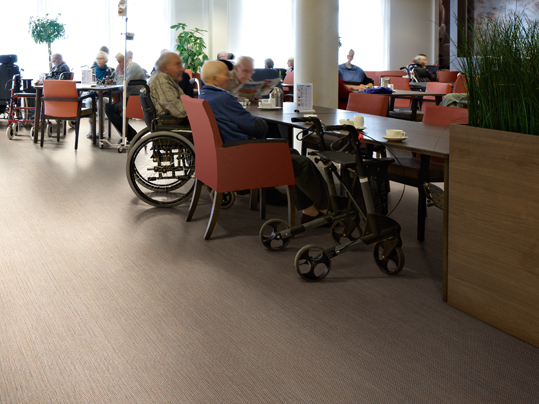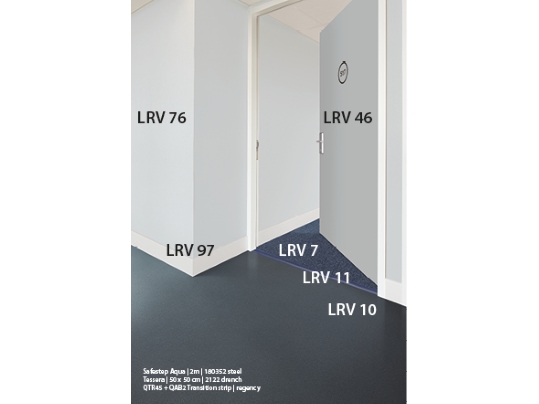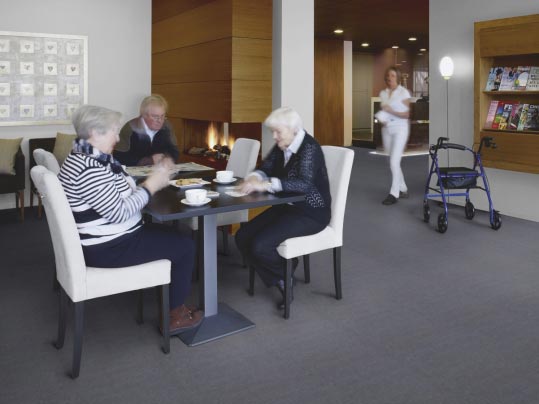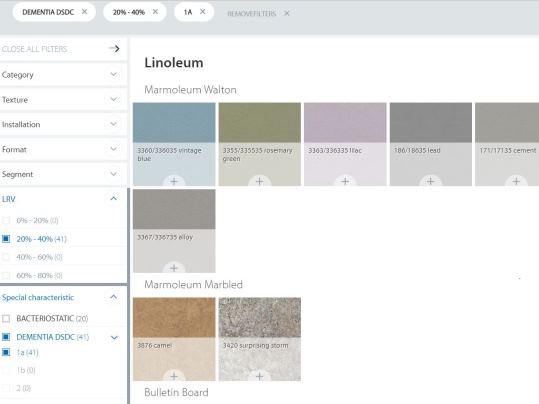Design for the Mind
Care Home Professional Roundtable
May 2019

Organised by Care Home Professional, we joined experts from the world of care home design, specification, research and operation to discuss the development of a fit for purpose dementia design framework.
Lesley Palmer (LP): Chief Architect, Dementia Services Development Centre (DSDC)
Amanda Cunningham (AC): Chief Operating Officer, Four Seasons
Rebecca Morgan (RM): Designer with BUPA care home designer Lusted Green
Samantha Ryding (SR): Senior Designer with BUPA care home designer Lusted Green
Elaine Shine (ES): Standards Consultant, BSI
Mark Jackson (MJ): Key Account Manager, Forbo Flooring Systems
Julie Dempster (JD): Marketing Manager, Forbo Flooring Systems
What is your assessment of the current guidelines for care home design and how they meet the needs of care home designers and providers?
Lesley Palmer (LP): I have written a few design guides both for children with autism and people with dementia and for general housing. All I can say with any certainty today is you can write design guides, but you cannot guarantee that people are going to read them. The dementia design principles came out 10 years ago and research that underpinned them came out 18 years ago and still we don’t see architects engaging with them. We are aware that there are many guidelines out there on dementia design in the market. Some are those are not based on evidence. Some are incorrect.


The DSDC operates an accreditation system with Forbo and many other suppliers. How does this work?
LP: We are working with a lot of flooring manufacturers throughout the UK, we are working with manufacturers of sanitary products and of profiling beds, and the more the better because then we start to have rooms that have several products that are all complementary. Forbo Flooring came for a full day’s training on dementia. We talked through how we accredited the product. There’s a core group of us looking for consensus. We blind review several of the products to see if they have parity on scoring. It’s quite a rigorous process.
Mark Jackson (MJ): We started to get a lot of requests from clients and we wanted to do something to help improve the level of dementia design within refurbished buildings.
Julie Dempster (JD): When we first started searching for guidelines on Dementia Design, we found quite a bit of conflicting information out there and so contacted DSDC for advice. We wanted to understand how appropriate our existing portfolio of products, regularly used within the Care sector, were in terms of creating dementia inclusive interiors.
"What was fascinating in the journey that we are making with Forbo is we found that we were having conversations about potential new products that I don’t think either of us would ever have considered without that synergy of the manufacturer on products and process and us on understanding design." Lesley Palmer, Chief Architect, DSDC
Can you tell us about the guidelines you have been developing with Bupa, Samantha (Ryding):
SR: Initially they are focused on the interior guidelines in terms of what fixtures and fittings we are putting in with a focus on dementia. For us it’s about being inclusive across the board. When we were looking at research into dementia design, we just found bad examples of how other people had done it. It’s difficult to sift through that information and know what the best thing to do is. Of course, we have an interest in how it looks aesthetically as well.
Where do you see care home dementia design going in terms of innovation?
SR: We are moving away from the 1950s lounges and looking at relating environments to where people have come from. It’s about creating a nice space that people want to live in and getting away from the nursery and themed spaces. I would like to understand how technology can be brought more into care homes as well as into people’s own homes as people will be living at home longer with dementia.

"Technology will be a massive contributor to innovation. We use iPads to assist our colleagues in managing people’s distressed reactions and medication and weight loss, etc. We are also looking at the use of alarm systems and support systems for falls and support and monitoring for people who may like to go out for a walk by themselves but need to be supported by someone. There’s technology around lighting and activities and sensory stimulation. For me it’s about embracing any innovation even if it impacts on the well-being of on just one person." Amanda Cunningham, Chief Operating Officer, Four Seasons

When you are looking at commercial aspects, are you looking at durability and infection control?
JD: All our flooring products selected for use in care are all fit for purpose. Identifying which ones were suitable for dementia design was the part that was missing. Now we have available on-line an interactive product selector with over 1,000 products that Lesley’s team have accredited so you can search by pattern, colour, functionality (including bacteriostatic properties, safety and acoustic performance apsects) AND dementia design suitability.
SR: It would be great to have some continuity among suppliers that can offer tonally complementary products.
JD: Tonal continuity is achieved when floors are no more than 10 LRV steps apart (ideally 8) and the LRV ratings of our all products are shown on our website to make selection easy. Plus we’re working with a partner who has developed specific transition strips that can maintain tonal continuity too.
"Having worked with DSDC for over three years now, we have been feeding back into our product development process the key dementia design principles. However, the key point for Care Providers to remember is that our accredited flooring must still be within 30 LRV steps of other critical surfaces. So we are very proactive in communicating the DSDC guidelines to be used alongside the accreditation scheme." Julie Dempster, Marketing Manager, Forbo Flooring Systems
Elaine, would you like to say something about what the BSI is doing in terms of developing new guidelines for neuro divergent environments?
ES: Two years ago, we commissioned a qualitative report around neuro divergent conditions and design for those conditions. We found that our BS80200 series, which focuses on physical impairment, did not go far enough to include people with dementia. The report was based around Euston station. It was based on surveys and interviews and physically working around spaces there as well as a hotel and restaurant in Paddington to see exactly what the design challenges were. That report developed 11 design themes on which we could base the standard app, covering clarity, layout, flooring, sensory, decoration, signage, familiarity, acoustics, safety, line of sight and lighting elements. The BS80200 series is a very developed standard so we can’t just fit in standards around dementia friendly design. We have to go through the evaluation process, so we are working with TfL and the Ministry for Housing and Communities and Local Government to developing a fast-tracked standard. This is a sponsored standard for industry that will take about nine to 12 months to develop. After that point, we can evaluate it over a period of time and the intention is that it will eventually fit into the BS80200 series.

If you would like to know more about Forbo's partnership with the DSDC and our accredited products, you can download our brochure using the link below.
Download the Forbo DSDC Guidelines Brochure